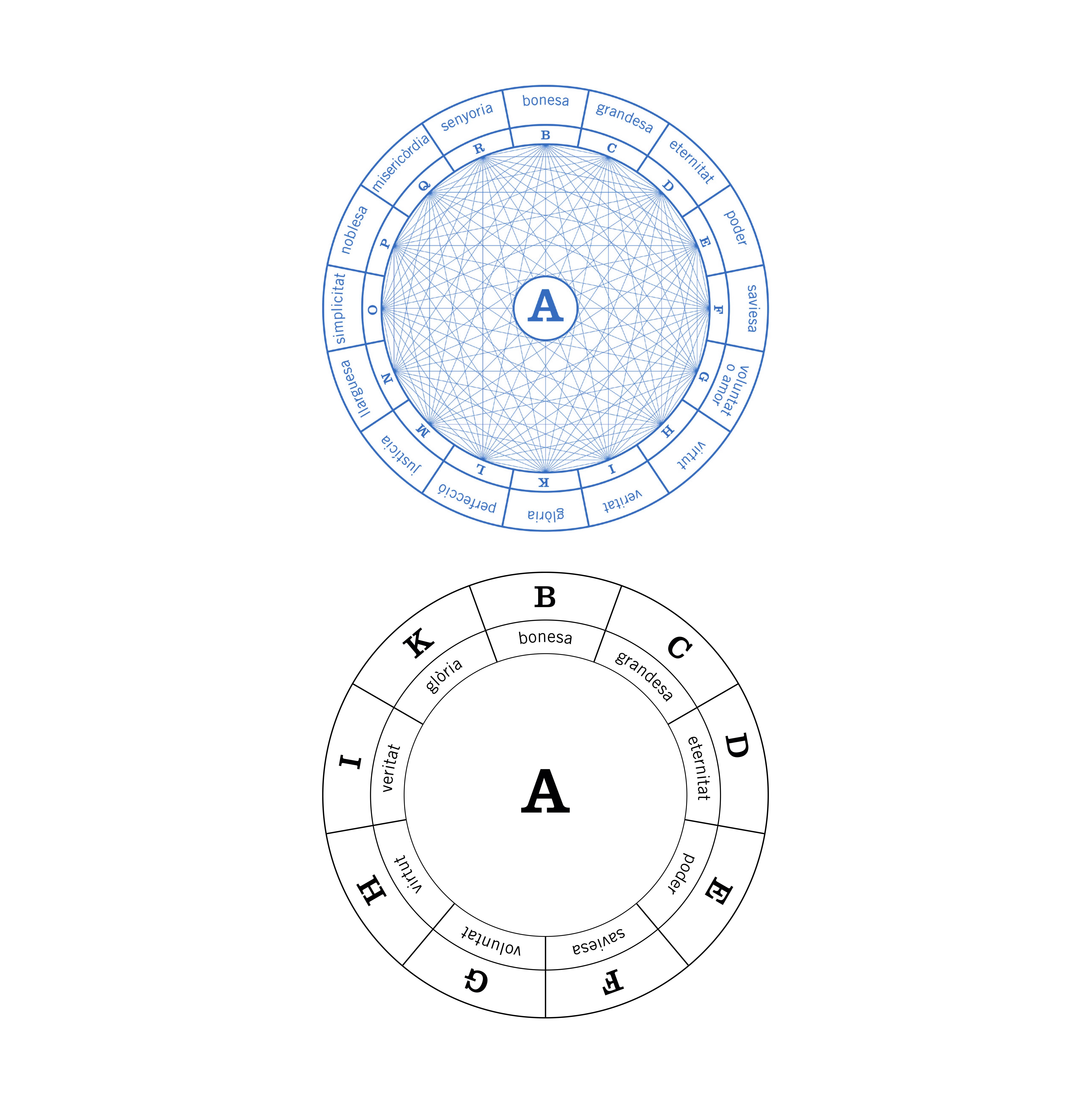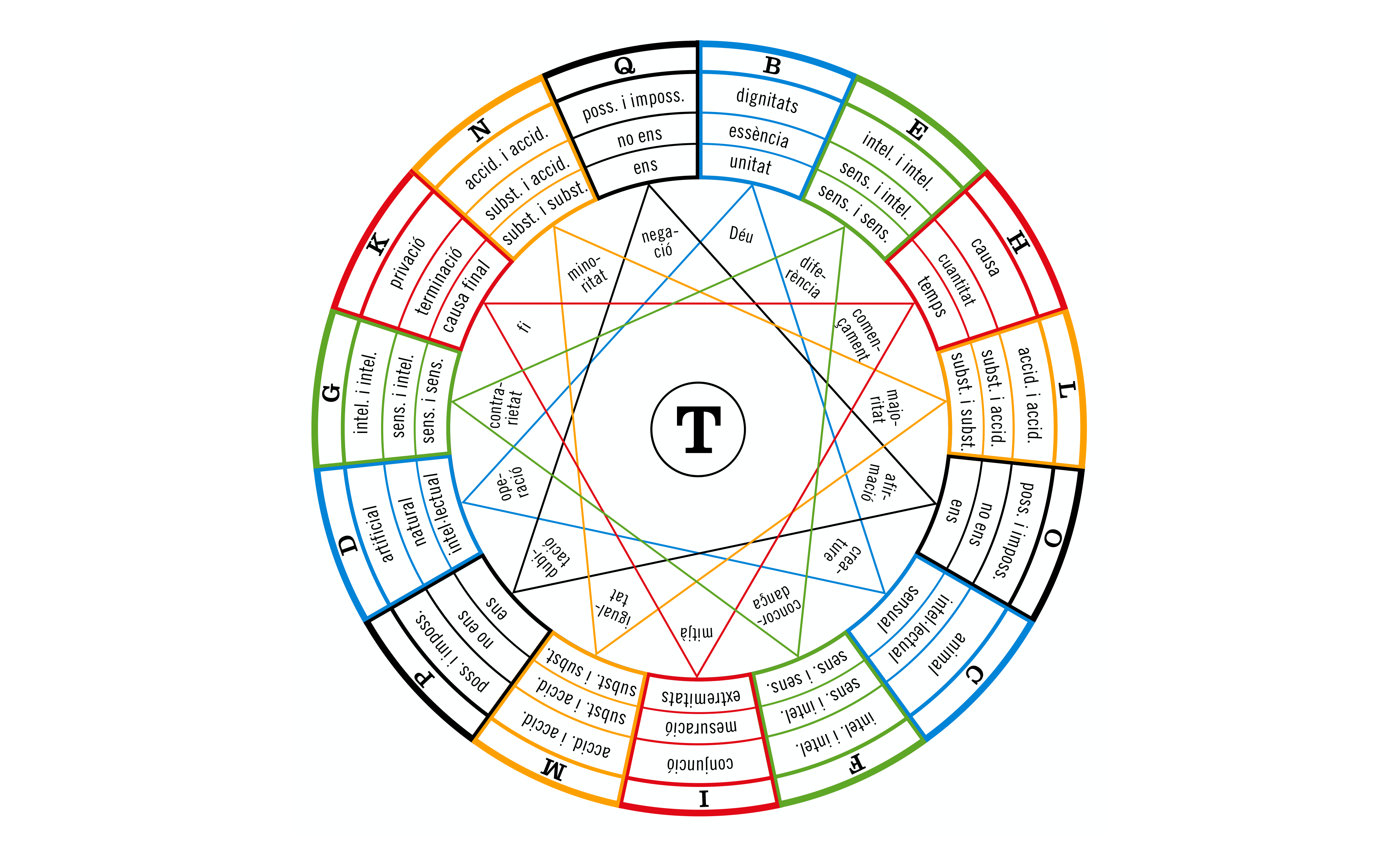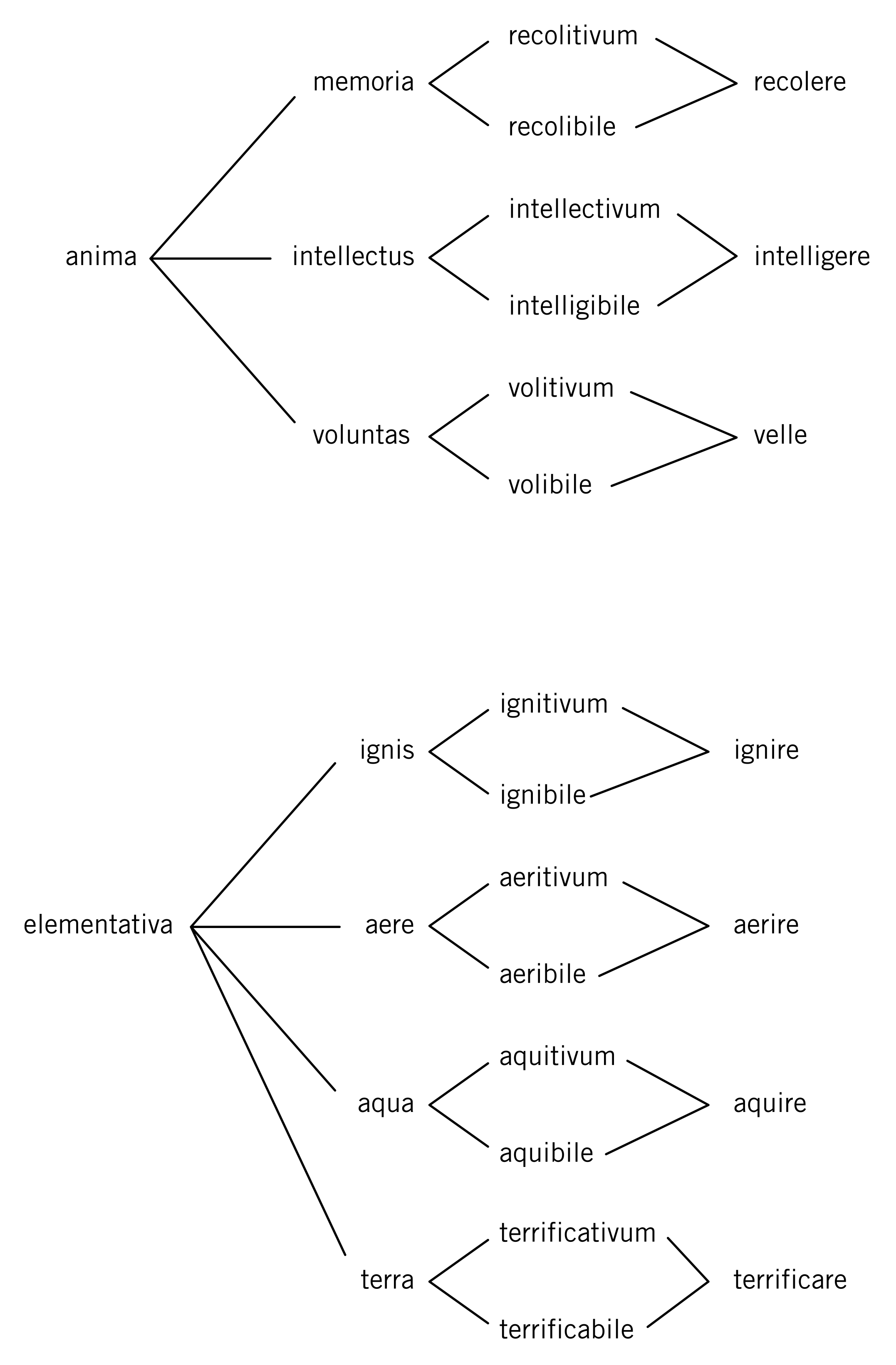- Introduction
- Context
- Life
- Thought
-
Works
- The multilingual nature of Llull's works
- Llull and the catalan language
- Diffusion and preservation
- Book of Contemplation
- Book of the Gentile
- Book of the Order of Chivalry
- Doctrina pueril
- Romance of Evast and Blaquerna
- Book of the Lover and the Beloved
- Ars demonstrativa
- Felix or the Book of Wonders
- Book of the Beasts
- Desconhort
- Tree of Science
- Exemplary Tree
- Cant de Ramon
- Rhetorica nova
- Logica nova
- Liber de fine
- Ars brevis
- Phantasticus
- Ars brevis praedicationis
- Gallery of images
- Database / Dictionary
The principles of the Art
Figura A

In the quaternary phase of the Art this figure exhibits sixteen attributes of God, which are called ‘dignities’ (or sometimes ‘virtues’), and whose semblances are reflected in created reality. The figure is drawn with a complete web of interconnecting lines to show that each of these dignities is concordant with all the others. In the ternary phase of the Art they are reduced to nine: goodness, greatness, eternity, power, wisdom, will, virtue, truth, and glory.
In the ternary phase of the Art, they are no longer called ‘dignities’, but just ‘principles’ because they no longer apply exclusively to God, but rather to the entire ladder of being. These respective roles are now differentiated by the fact that in the created world they can be distinguished from one another but coincide and are identical in God, where they can be predicated of each other. In God, for example, goodness is great, and greatness is good. It was in this fact that the distinctive mark of God resided, enabling us to define him exclusively: God is the being in whom goodness, greatness, eternity and the other dignities coincide; from which it followed that demonstration per aequiparantiam or argument by identity —the identity of God with His dignities and of these with themselves.
Figura T

This second set of principles was established in the quaternary Art to determine the possible modes of relationship existing between other concepts of the Art. It consisted of five triangles with three concepts each: God, creature, operation; difference, concordance, contrariety; beginning, middle, end; majority, equality, minority; affirmation, doubt, negation.Thus Llull could establish, for instance, the concordance between two dignities, or the contrariety between a virtue and a vice. In the ternary Art the first and last triangles disappear, and the components of the figure are thus reduced to nine. They are also now defined, as for instance ‘Concordance is that by reason of which goodness, etc., accord in one or in several things.’ They are now too general principles, applicable to the entire ladder of being (with the exception of ‘contrariety’ and ‘minority’ which have no place in God), and they can be ‘mixed’ with the principles of Figure A to produce the required arguments.

The doctrine of the principles was completed by that of the ‘correlatives’, an original articulation of Llull’s dynamic ontology. The correlatives had their origins in an unfolding of the nominal forms of transitive verbs: the present participle as an active form, the past participle as the passive and the infinitive as the nexus between the two. Llull thus rendered general a doctrine which Saint Augustine, in an attempt to explain the Trinitarian mystery, had applied to verbs expressing the soul’s activities (‘knowing’, ‘known’ and ‘to know’, ‘loving’, ‘beloved’ and ‘to love’, etc.). Each of Llull’s principles, therefore, once converted into essentially active forces, expanded to form the triad of their correlatives (‘Bonitas’, for example, = ‘bonificativus’, ‘bonificabile’ and ‘bonificare’; ‘magnitudo’ = ‘magnificativus’, ‘magnificabile’ and ‘magnificare’, etc.). Even Llull was aware that readers might be alarmed by such eccentric and apparently nonsensical language! But he was not talking nonsense. What he wished to express by this strained and ungainly terminology was the profound sense that God was infinitely active and fecund and that, therefore, his dignities could not remain eternally idle and sterile. From this new theory, the principle axis of Llull’s theology, could be deduced the rationality of the Trinity and the Incarnation. The theory, however, was also relevant from the philosophical point of view. As an expression of a dynamic conception of being, the correlatives set the entire edifice of Llull’s system in motion. Through them, even the world participated in the vital Trinitarian rhythm found throughout God’s creation.
The Art was made complete through a series of signs and graphic devices by which Llull expressed its elements and their combinations. The chief ones were the Alphabet, the Figures and the Table. The Alphabet assigned letters to various concepts of the Art. In the quaternary phase—in the Ars demonstrativa for example—the twenty-three letters of the medieval Latin alphabet stand for a complicated array of concepts and figures. In the ternary phase the letters from B to K stand for the nine concepts of each series of the Art’s components (fundamentally those of Figures A and T). The Figures were used to group the various concepts of the Art in homogeneous sets. In the quaternary phase they were twelve or sixteen in number, and, with one exception, they were of two sorts: one was circular with criss-crossed lines to show concordances between components; the other was a triangular display of binary compartments, a display technically called a ‘half-matrix’, corresponding one each to the circular figures. The one exception was the Elementary Figure composed of four squares with sixteen compartments displaying the various combinations of the four elements of medieval physiology: earth, air, fire, and water. In the ternary phase the figures were reduced to four: two circular ones for A and T (no longer with the criss-crossed lines), one half-matrix for possible binary combinations of the nine letters of the Alphabet, and a rotating figure showing all the possible ternary combinations of those same letters. Finally the Table, in 84 columns of 20 components each, worked out all the possible ternary combinations implicit in the rotary Fourth Figure.
The interplay of all these elements gave rise to a ‘combinatorics’. In fact, Llull, in keeping with medieval logic, conceived of his Art as a tool for forming judgements and syllogisms. As we have seen, with this end in mind, he began by assigning a letters to various concepts of the Art. Then, by means of binary and ternary combinations of letters, he established the necessary relationship between the terms of a judgement or of a number of judgements. Llull called this operation ‘fer cambres’ [‘the formation of compartments’]. This entire mechanism was directed towards a specific end: to discover in any subject area the appropriate terms for forming judgements and syllogisms and thus to construct logical reasoning by a form of mathematical necessity. Here, that is to say, in this attempt, at once ingenuous and possessed of genius, to mechanise and mathematise knowledge, a distant anticipation of modern symbolic logic, certainly lay the roots of that peculiar seductive power exerted by Llull’s Art throughout history, from the time of Nicholas of Cusa to that of Leibniz.